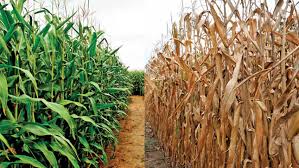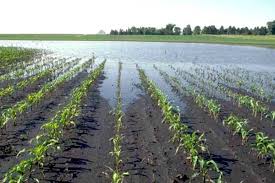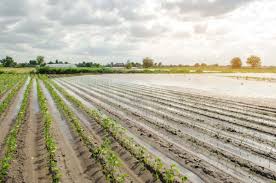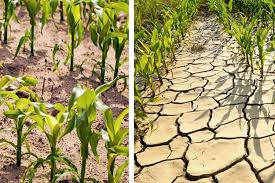Climate change refers to significant shifts in weather patterns over extended periods, often decades or longer. It is primarily driven by human activities, such as the burning of fossil fuels, deforestation, and industrial activities, which release greenhouse gases like carbon dioxide, methane, and nitrous oxide into the atmosphere.
These gases trap heat, leading to global warming and contributing to changes in precipitation, rising sea levels, extreme weather events, and shifts in growing seasons.
Climate change is one of the most pressing issues today, with wide-ranging impacts on ecosystems, economies, and societies worldwide. One of the sectors most vulnerable to climate change is agriculture, which is highly sensitive to changes in temperature, rainfall, and atmospheric conditions.
Agriculture is essential to human survival, providing food, fiber, and fuel. However, it depends heavily on stable weather conditions, making it particularly susceptible to the adverse effects of climate change. Shifts in climate patterns can lead to unpredictable growing seasons, affect crop yields, and pose risks to food security.
This impact is already visible in many parts of the world, where farmers are experiencing reduced productivity and struggling to adapt to new climate realities.
Rising temperatures are a key component of climate change, directly affecting plant growth. Many crops have specific temperature ranges within which they thrive; beyond these ranges, growth slows, and yields may decline. For instance, higher temperatures can accelerate the growth cycle of plants, leading to shorter growing seasons and smaller harvests.
This can also disrupt the life cycles of pests and diseases, which thrive in warmer climates and can attack crops more frequently and intensely. Additionally, extreme heat can harm animals raised for food, reducing their productivity and health.
Another significant impact of climate change on agriculture is the alteration of rainfall patterns. Some regions are experiencing more intense droughts, while others face increased flooding.
Droughts can reduce water availability, which is crucial for crop irrigation and livestock. Without sufficient water, crop yields drop, and pastures become less productive, which affects food supplies and livestock grazing.
Conversely, excessive rainfall can lead to waterlogged soils, which hinder plant growth, cause root diseases, and damage infrastructure. This variability makes it challenging for farmers to plan and manage their resources effectively.
Soil quality is another factor influenced by climate change. Increased rainfall and flooding can lead to soil erosion, where topsoil is washed away, leaving behind less fertile land. Droughts can also lead to soil degradation, as dry soil becomes more prone to erosion by wind. This loss of fertile soil reduces the land’s productivity over time, leading to decreased agricultural yields. Soil degradation affects not only current crop production but also the long-term sustainability of agriculture in many regions.
To address these challenges, the agricultural sector must adapt to changing climate conditions. This includes implementing climate-resilient practices, such as crop rotation, improved irrigation techniques, and soil conservation methods. Additionally, breeding crops for heat tolerance and drought resistance can help ensure food security in a changing climate.
Agricultural practices must evolve to maintain productivity and sustainability as the effects of climate change intensify.
Climate change presents significant challenges to agriculture by disrupting weather patterns, affecting crop growth, altering water availability, and degrading soil quality.
Addressing these impacts requires a combination of adaptation strategies and sustainable farming practices to ensure resilience in the face of climate uncertainty.
Understanding the Causes of Climate Change

Climate change is primarily driven by human activities that release greenhouse gases and alter the natural balance of the Earth’s atmosphere. Over the last century, the rapid increase in industrialization, deforestation, and the consumption of fossil fuels has accelerated the warming of the planet.
To understand the causes of climate change, it’s essential to examine the main sources of greenhouse gases and other contributing factors. Here are the primary causes of climate change:
1. Burning of Fossil Fuels: The combustion of fossil fuels like coal, oil, and natural gas for energy is the largest source of carbon dioxide (CO₂) emissions. These fuels are commonly used for electricity production, transportation, and industrial processes.
When burned, they release large amounts of CO₂ into the atmosphere, where it traps heat and contributes to global warming. The use of fossil fuels has been increasing since the Industrial Revolution, significantly contributing to the rise in global temperatures.
2. Deforestation and Land Use Changes: Forests act as carbon sinks, meaning they absorb CO₂ from the atmosphere. However, deforestation particularly in tropical regions is leading to the loss of these vital ecosystems. When trees are cut down or burned, the carbon stored in them is released back into the atmosphere.
Additionally, land use changes, such as converting forests into agricultural lands, reduce the Earth’s ability to absorb CO₂, further contributing to climate change.
3. Agricultural Practices: Agriculture is a significant contributor to greenhouse gas emissions, particularly methane (CH₄) and nitrous oxide (N₂O). Livestock, such as cattle, produce methane during digestion, and rice paddies release methane as well.
Additionally, the use of synthetic fertilizers and manure in agriculture leads to the emission of nitrous oxide, a potent greenhouse gas. These gases trap heat in the atmosphere, contributing to the warming of the planet.
4. Industrial Processes: Certain industrial activities release greenhouse gases and pollutants into the atmosphere. For example, cement production involves the chemical transformation of limestone, which releases CO₂ as a byproduct.
Similarly, the production of various chemicals and metals also generates greenhouse gases. Industrial processes often rely on fossil fuels for energy, compounding their impact on climate change.
5. Waste Management and Landfills: Waste management practices, particularly landfills, are another source of greenhouse gas emissions. When organic waste decomposes in landfills, it produces methane a greenhouse gas far more potent than CO₂. Poor waste management practices, such as the improper disposal of waste, contribute to methane emissions, exacerbating climate change.
6. Transportation: The transportation sector is a significant contributor to global greenhouse gas emissions, mainly due to the reliance on fossil fuel-powered vehicles. Cars, trucks, airplanes, and ships release CO₂ and other pollutants into the atmosphere.
With the rapid growth of urbanization and increased demand for goods, transportation emissions continue to rise, contributing to climate change.
7. Natural Causes: While human activities are the primary drivers of recent climate change, some natural factors also play a role. These include volcanic eruptions, which can release large amounts of CO₂ and particulates into the atmosphere, and natural variations in solar radiation.
However, natural causes alone cannot account for the rapid pace of warming observed in recent decades.
Changes in Temperature and Their Impact on Crop Yields
Temperature changes are one of the most immediate effects of climate change, and they significantly impact crop yields. Here’s how rising temperatures affect agricultural production:
1. Altered Growing Seasons: Rising temperatures can extend growing seasons in some regions, allowing multiple crops per year. However, in areas already near temperature limits, extreme heat can stress plants and reduce productivity.
2. Increased Heat Stress: High temperatures can lead to heat stress in crops, which may inhibit photosynthesis and reduce growth. Crops like wheat, corn, and rice are particularly sensitive to temperature spikes during critical growth stages.
3. Shift in Crop Viability: Temperature changes can make some regions unsuitable for traditional crops, forcing farmers to switch to different varieties or crops more resistant to heat. This shift requires adjustments in farming practices and can impact local economies.
4. Enhanced Pest and Disease Pressure: Warmer temperatures can promote the spread of pests and diseases that damage crops. Insects, fungi, and pathogens that thrive in warm climates are expanding into new areas, challenging farmers to find effective pest management strategies.
5. Water Demand Increase: Higher temperatures can lead to increased evaporation rates, boosting crops’ water demand. In regions facing water scarcity, this demand can strain water resources and affect crop production.
Read Also: Hog Cholera (classical swine fever): Description, Damages Caused, Control and Preventive Measures
Effects of Altered Rainfall Patterns on Agriculture

Climate change is causing shifts in rainfall patterns, which directly affect agricultural practices and water availability. Here’s how altered rainfall patterns impact agriculture:
1. Drought Conditions: Prolonged droughts can lead to water shortages that hinder crop growth and reduce yields. Drought-resistant crop varieties and improved irrigation methods are essential in combating the effects of limited rainfall.
2. Increased Flood Risk: In some areas, climate change causes more intense rainfall events, leading to flooding. Flooding can damage crops, wash away fertile soil, and disrupt planting schedules, creating challenges for farmers.
3. Soil Erosion: Altered rainfall patterns can accelerate soil erosion, especially during heavy rains. Erosion reduces soil fertility, making it difficult for plants to access essential nutrients, which ultimately impacts crop productivity.
4. Changes in Crop Suitability: Rainfall variability affects crop selection, as certain crops require specific amounts of water. Farmers may need to switch to drought-tolerant crops or modify their planting techniques to adapt to unpredictable rainfall.
5. Water Resource Management Challenges: Altered rainfall patterns make water resource management more challenging. Farmers increasingly rely on efficient irrigation systems and water conservation practices to manage water use effectively.
How Climate Change Affects Soil Health
Soil health is essential for sustainable agriculture, but climate change poses significant threats to soil quality and productivity. Here’s how climate change impacts soil health:
1. Soil Degradation: Rising temperatures and altered rainfall patterns can lead to soil degradation, affecting its structure, nutrient content, and ability to support plant growth. Degraded soil requires more inputs, such as fertilizers, to maintain productivity.
2. Reduced Organic Matter: Higher temperatures can accelerate the breakdown of organic matter in the soil, reducing its nutrient content. Organic matter is essential for soil fertility, water retention, and overall soil health.
3. Increased Salinity: In regions facing higher evaporation rates due to rising temperatures, soil salinity can increase as water is drawn out of the soil, leaving salts behind. Saline soils reduce crop yields and limit the types of crops that can be grown.
4. Soil Erosion Intensification: Climate change can worsen soil erosion due to more intense rainfall events and reduced vegetation cover. Erosion strips away topsoil, reducing soil fertility and productivity.
5. Altered Soil Microbial Activity: Soil microorganisms are crucial for nutrient cycling and soil health. Climate change can disrupt microbial communities, impacting nutrient availability and soil structure.
Read Also: Hog Cholera (classical swine fever): Description, Damages Caused, Control and Preventive Measures
The Role of Extreme Weather Events in Agricultural Losses

Extreme weather events such as hurricanes, floods, droughts, and heatwaves are becoming more frequent due to climate change, resulting in significant agricultural losses.
1. Crop Destruction: Hurricanes and floods can destroy entire fields, damaging crops beyond recovery. Extreme wind and water damage can cause immediate loss of yield, impacting both local and global food supplies.
2. Soil Degradation: Flooding and heavy rainfall can lead to soil erosion, reducing soil fertility. This degradation means that recovering farmland takes more time and resources, affecting future harvests.
3. Supply Chain Disruptions: Extreme weather events can disrupt transportation networks, making it challenging to distribute harvested crops. Damage to infrastructure, such as roads and storage facilities, can lead to delays and losses during peak seasons.
4. Increased Costs: Weather-related crop losses drive up production costs as farmers may need to invest in disaster recovery, replanting, and restoring damaged land, ultimately affecting the price of food products.
5. Risk of Food Shortages: Significant agricultural losses can lead to reduced food supplies, affecting prices and accessibility. In regions highly dependent on agriculture, this can lead to food insecurity and economic instability.
Water Scarcity and Its Consequences for Farming
Water is crucial for agriculture, but climate change is exacerbating water scarcity, especially in areas already prone to drought.
1. Reduced Crop Yields: Droughts limit the availability of water for irrigation, reducing crop yields and making it difficult for farmers to sustain production levels. Crops like rice, maize, and wheat are particularly vulnerable.
2. Soil Salinization: In areas with limited water resources, high rates of evaporation can leave salts behind in the soil, leading to salinization. This process makes it harder for plants to absorb water and nutrients, reducing crop health.
3. Increased Dependence on Irrigation: As rainfall becomes more unpredictable, farmers rely more on irrigation systems. However, this can lead to overuse of water resources, which further depletes available freshwater supplies.
4. Water Conflicts: In regions where agriculture competes with urban and industrial water needs, water scarcity can lead to conflicts over limited resources. This competition is particularly intense in arid areas with large agricultural sectors.
5. Adaptation Costs: Adapting to water scarcity often requires investment in efficient irrigation systems, rainwater harvesting, and drought-resistant crop varieties. These adaptations can be costly, particularly for small-scale farmers.
Climate Change and Increased Pest and Disease Pressure
Warmer temperatures and shifting weather patterns are causing pest and disease pressures to increase, posing a major threat to agriculture.
1. Expansion of Pest Ranges: Many pests that were previously limited to specific regions are expanding their ranges as temperatures rise. This expansion increases the risk of crop infestations in new areas.
2. Increased Insect Populations: Warmer temperatures and longer growing seasons allow for more generations of pests, like aphids, locusts, and beetles. These pests can devastate crops if left uncontrolled.
3. Disease Proliferation: Climate change also facilitates the spread of plant diseases, such as blights, rusts, and fungal infections. Warmer and wetter conditions create an ideal environment for pathogens to thrive.
4. Increased Pesticide Use: To combat rising pest pressures, farmers may resort to using more pesticides. This increase can lead to higher production costs and potential environmental impacts, including harm to pollinators and beneficial insects.
5. Threat to Food Security: With more pests and diseases affecting crops, farmers may experience decreased yields, leading to reduced food supplies and higher food prices, particularly in regions dependent on agriculture.
Impact on Livestock and Animal Health
Climate change also affects livestock, with implications for animal health, productivity, and overall farm sustainability.
1. Heat Stress: Higher temperatures put livestock at risk of heat stress, reducing their ability to produce milk, meat, and other products. Heat stress can also lead to increased mortality rates, particularly during extreme heat events.
2. Reduced Water Availability: As water resources become scarce, providing adequate hydration for livestock becomes challenging. Water scarcity can impact animal health, productivity, and growth rates.
3. Altered Feed Quality: Climate change can affect the nutritional quality of pasture and forage. Drought conditions, for example, may reduce forage availability and quality, leading to higher feed costs for livestock farmers.
4. Disease Vulnerability: Warmer temperatures and changing ecosystems can increase the prevalence of diseases that affect livestock, such as tick-borne illnesses. Livestock farmers may need to invest in additional veterinary care and vaccinations.
5. Increased Management Costs: Adapting livestock operations to changing conditions may require significant investments in shade structures, water management, and improved ventilation systems. These costs can strain farm finances, especially for smaller operations.
Changes in Growing Seasons and Crop Viability
Shifting climate patterns have led to changes in growing seasons, impacting crop viability and requiring farmers to adjust their practices.
1. Altered Planting and Harvesting Times: As temperatures increase, growing seasons may lengthen in some regions, allowing for earlier planting and later harvesting. However, this can also expose crops to higher heat stress.
2. Crop Suitability Shifts: Crops that once thrived in certain areas may no longer be viable as conditions change. For example, some staple crops may need cooler temperatures, pushing their production to higher altitudes or latitudes.
3. Impact on Crop Yields: Warmer temperatures and changing precipitation patterns can reduce crop yields, especially for temperature-sensitive crops like wheat and rice. Adapting to these changes may involve altering crop choices and diversifying plant varieties.
4. New Pest and Disease Pressures: Changes in growing seasons can encourage the spread of pests and diseases that thrive in warmer conditions, increasing the risks to crops during their growth stages.
5. Increased Management Complexity: Farmers must adapt to the variability in growing seasons by employing different planting strategies and crop rotations to maximize yields and maintain soil health.
The Role of Climate-Resilient Crops in Mitigating Impacts
Climate-resilient crops play a vital role in helping agriculture adapt to changing conditions and maintaining food security.
1. Drought-Tolerant Crops: Crops engineered or selectively bred for drought tolerance can survive with less water, making them valuable in areas experiencing increased water scarcity.
2. Heat-Resistant Varieties: Some crops are developed to withstand higher temperatures, reducing the risk of heat stress and promoting stable yields despite rising temperatures.
3. Salt-Tolerant Crops: In regions affected by soil salinization due to irrigation or sea-level rise, salt-tolerant crops can maintain productivity in otherwise challenging conditions.
4. Pest-Resistant Strains: Breeding or genetically modifying crops to resist common pests can help reduce losses, particularly as pest ranges expand with warmer temperatures.
5. Nutrient-Enhanced Crops: Crops developed to retain nutritional value under stress conditions help address food security by ensuring that yields remain nutritious even as environmental conditions shift.
Technological Innovations to Adapt Agriculture to Climate Change
Advances in technology offer tools and methods to support agricultural adaptation to climate change, enhancing efficiency and sustainability.
1. Precision Agriculture: Precision tools like GPS-guided machinery and sensors help farmers monitor soil conditions, water needs, and crop health, allowing for more targeted resource use.
2. Climate-Smart Irrigation: Smart irrigation systems can optimize water usage based on real-time weather data, reducing water wastage and improving crop yields under water-scarce conditions.
3. Use of Drones and Satellites: Drones and satellite technology provide aerial views of fields, enabling farmers to monitor crop growth, detect pest infestations early, and assess field health.
4. Data Analytics and AI: Data-driven insights enable farmers to make informed decisions on crop selection, planting times, and pest control, helping them adapt quickly to changing environmental conditions.
5. Controlled Environment Agriculture: Technologies like greenhouses and vertical farming allow for year-round production in controlled settings, reducing vulnerability to external climate variability.
Policy Measures to Support Sustainable Agriculture
Policy initiatives play a crucial role in promoting sustainable agricultural practices that mitigate climate change impacts and enhance resilience.
1. Incentives for Climate-Resilient Practices: Governments can encourage sustainable practices by providing subsidies, tax breaks, or grants for adopting climate-smart technologies and resilient crop varieties.
2. Research and Development Funding: Investment in agricultural research can support the development of new technologies and resilient crop varieties, enabling faster adaptation to changing conditions.
3. Water Management Regulations: Policies aimed at conserving water resources, such as irrigation quotas and water-saving incentives, can ensure sustainable water use in agriculture.
4. Support for Smallholder Farmers: Programs that provide financial aid, training, and resources to smallholder farmers help them access the tools and knowledge needed to adapt to climate change.
5. International Collaboration: Global partnerships on agricultural innovation and climate resilience encourage the sharing of knowledge and resources, fostering a more coordinated response to climate challenges.
Do you have any questions, suggestions, or contributions? If so, please feel free to use the comment box below to share your thoughts. We also encourage you to kindly share this information with others who might benefit from it. Since we can’t reach everyone at once, we truly appreciate your help in spreading the word. Thank you so much for your support and for sharing!
Read Also: How To Fix a Garbage Disposal Jam

